On the one hand, you love those golden rays of summer sunshine! They brighten your home and spirits, rousing your energy and enthusiasm. Still, without buffers in place, that vibrant sunlight generates stifling indoor heat.
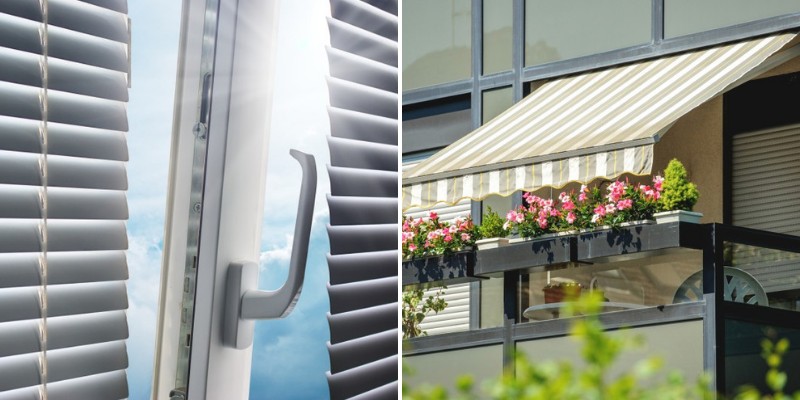
Thankfully, using window treatments, you can curb the amount of solar heat entering your home. Here are 10 effective option to consider for blocking sunlight heat from your windows.
Heat Transfer
A standard single-pane window doesn’t manage heat well. During winter, it lets 30 percent of your household heat escape.
On summer days, the glass invites up to 90 percent of the sun’s heat into your home. This passive solar energy transmission is called “heat transfer.”
Advantages of Blocking Sunlight Heat from Windows
Some types of window coverings reduce heat transfer by up to 77 percent! Plus, during fall and winter, they prevent heat loss. Thus, your rooms will be comfier year-round.
Moreover, your cooling and heating costs will be lower, possibly by 25 percent or more. Your specific cost savings depend on:
– your chosen window covering
– how you implement it
– your particular climate
Some window treatments preserve outdoor views. Meanwhile, they keep the sun’s ultraviolet rays from fading your furniture, artwork, and carpeting.
So, all told, there are six advantages of using window treatments! Now, let’s explore several options for blocking heat suiting a range of budgets.
Interior Shades
Shades have a simple design, managing sunlight while conferring privacy. They can also help you sleep better by muting outdoor sounds.
Roller Shade
This is a sturdy sheet of material wrapped around a roller bar, secured at the top of your window. Mechanisms can be corded or spring-activated. A corded roller shade has a continuous loop system, the cord attached to a pulley.
Choose from light-filtering, room-darkening, or blackout materials.
Roman Shade
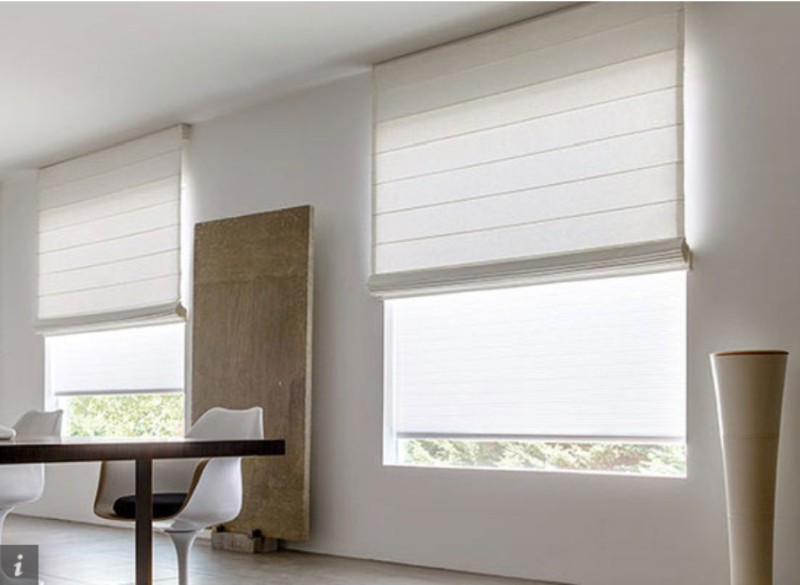
This window treatment is elegant! It differs from a roller shade by having pleated fabric. Typically, it operates via cords and rings on the back, raising and lowering the shade. As the fabric ascends, it stacks neatly upon itself. The resultant folds can be crisp or soft.
By choosing a Roman shade with a liner, you can moderate the sunlight it allows. A liner can filter the sun’s rays or darken a room.
Insulating Effect
Both roller and Roman shades come in quilted fabrics with fiber batting. By this, they offer a measure of defense against heat transfer.
To gauge how much insulation a shade provides, note its “R-value.” This number reveals how much heat the material resists. R-values range from 0.9 to 5.0, the higher numbers reflecting more insulating power.
Blinds
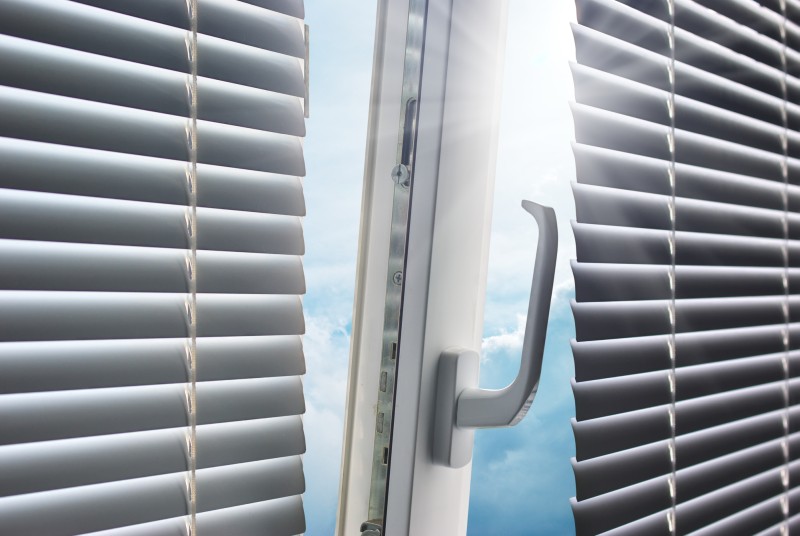
Like shades, blinds mount at the tops of your windows. Their rigid slats enable you to control the amount of sunlight entering. Slats can be vertical or horizontal, creating an orderly, structured look to your windows.
Ideally, choose “reflective blinds.” Their sun-facing surfaces repel solar heat, directing it back through window glass. Meanwhile, their room-facing sides are opaque, blocking sunlight. When completely shut, reflective blinds can slash solar heat gain by 45 percent.
Such window treatments are also called “blackout blinds.” Their slats descend from a cassette window system. When you lower the blind, the slats fill the window frame, blocking light from the sides.
Generally, R-values for horizontal blinds range from 2.5 to 3.0, lower than interior shades.
Cellular Shades
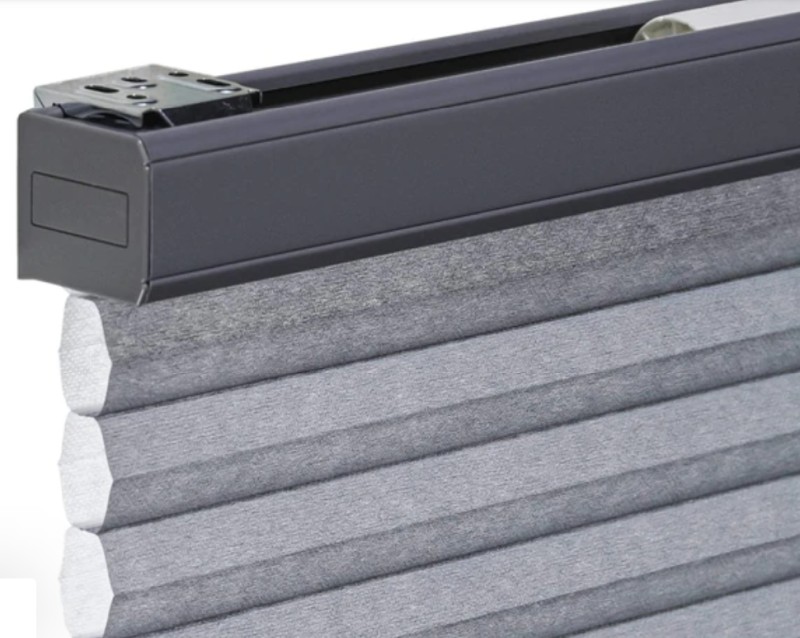
You’ve probably seen insulated cellular shades on windows in your own home or in neighbor’s homes. They have a pleated look that folds up like an accordion when you want to let natural light in.
They can come up from the bottom or down from the top, depending on the style that you choose. The insulation is included in the form of different layers that block heat from coming into the home in the summer and from being lost during the winter.
There are various air pockets in a series of honeycomb shaped layers that provide an exceptionally high R-value for your home from this shade option.
R-value refers to a resistance in heat flow. You can save a lot of money by adding additional insulation to your home, sometimes as simply as investing in new shades.
Not to mention, they can also provide you with the privacy and room darkening effect that you’re interested in.
There are a few different styles of cellular shades that you’ll find at your local window treatment store or online. The ones that have side tracks as part of their design are the most efficient and save the most energy.
If you’re really interested in saving money on energy costs and keep up with the latest and greatest technological developments, there are automatic blinds that you can open and close with a remote control.
Many of them can even be set on a timer that will open and close them automatically. You can choose your times based on the location of the sun in proximity to your home throughout the day so that you’re saving energy but you’re also letting light in and out when you need it most.
Curtains and Drapes
First, let’s clarify how curtains and drapes differ. Generally, curtains consist of lighter fabrics, sized to fit the windows they dress. Drapes extend to the floor and have a more formal look.
Plus, since drapes are heavier and lined, they block more light than curtains. Medium-colored drapes with white plastic liners can prevent solar heat gain by 33 percent.
During summer, for the greatest comfort, keep curtains and drapes closed. Ideally, hang them from “wraparound rods.” This way, the material will hug your walls, obstructing light from the sides of your windows.
If you’d rather not buy wraparound rods, attach the fabric to your walls with magnetic tape or Velcro. If a window has two curtains or drapes, overlap and tape them in the middle.
Drapery Upgrade
A cornice is a worthwhile drape accessory. It covers a drape at the top, further restraining heat transfer.
Cornices can be boxy, rectangular, or scalloped, giving drapes a refined touch. They can also sport decorative fabric. Typically, cornices are made of wood, foam insulation, or Styrofoam.
Adhesive Window Film Blocker
Are your summers long and your winters mild? If so, consider applying adhesive window film. Transparent film lets more daylight pass through window glass.
Reflective film has mirror-like properties, bouncing sunshine away from your home.
Reflective film has these advantages:
– potentially reducing solar heat by 80 percent
– guarding your furnishings against fading by the sun’s ultraviolet (UV) rays
– rendering privacy during daylight, preventing people from seeing inside
– reducing glare on electronic screens
Adhesive film works best on glass windows facing east or west. Are you handy and detail-minded? In that case, apply the material yourself, watching a video for guidance.
You’ll need to carefully prep each window, cut the film to size, and seal it properly. Alternatively, you can hire a professional installer.
Typically, window films have three layers. The adhesive, reflective side faces the sun, backed by a polyester layer and a scratch-resistant covering. You can also buy tinted film.
Reflective films have two downsides. Your windows will look darker while being harder to clean. Although films are removable, it’s best to hire a professional for this purpose, skilled in protecting window glass.
Performance Ratings
When shopping for window film, note its energy performance rating, consisting of two scores:
– Solar Heat Gain Coefficient (SHGC) – the film’s ability to transmit solar heat.
– Visible Transmittance (VT) – how much light the film allows through a window.
With both factors, the numbers range from 0 to 1. The most effective films have low SHGC and VT scores, indicating more shading capacity.
External Window Shading
Outdoor shades halt sunlight before it enters your home. High-quality sunscreens can block up to 97 percent of solar heat and UV rays. Any remaining solar energy is absorbed, reflected, or diffused. In turn, sunscreens eliminate glare.
Also called “sunshades,” they work like interior roller shades. When not needed, you simply retract them. Models can be motorized or manual, operated with an indoor crank.
Sunshade material is vinyl or fabric, each providing a clean, simple look. For the best window views, choose a dark fabric.
Window Awnings
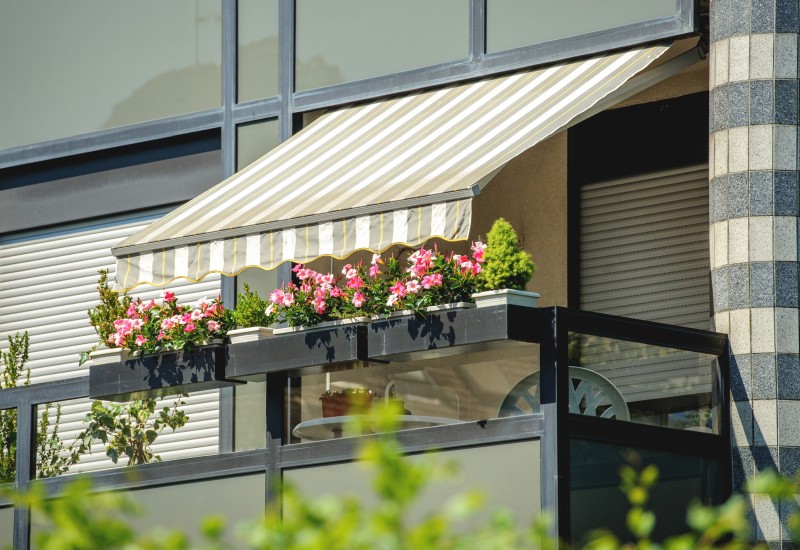
A window awning works like a brim on a baseball cap. On a west-facing window, an awning can rebuff solar heat by 77 percent. Light-colored types reflect the most sunlight.
Awnings have versatility! They can shade specific windows or one side of your house. They can also shelter outdoor living areas, such as a patio. Moreover, awnings can be retractable or stationary.
Over the years, designs have progressed. You’re no longer limited to canvas or metal, needing refurbishing every five to seven years. Now, awnings come in synthetic materials that:
– repel water
– discourage mildew
– resist fading, soil, and stains
– inhibit fire
A retractable awning has seasonal adaptability. During summer, keep it extended. On the brink of winter, close it up, taking advantage of the warming sun. Operation is a pleasure, thanks to metal arms, pulleys, or motorization.
Moreover, awnings can be decorative, featuring attractive colors, patterns, and stripes. If you want a fabric awning, choose an opaque, tightly woven product.
Window Inserts
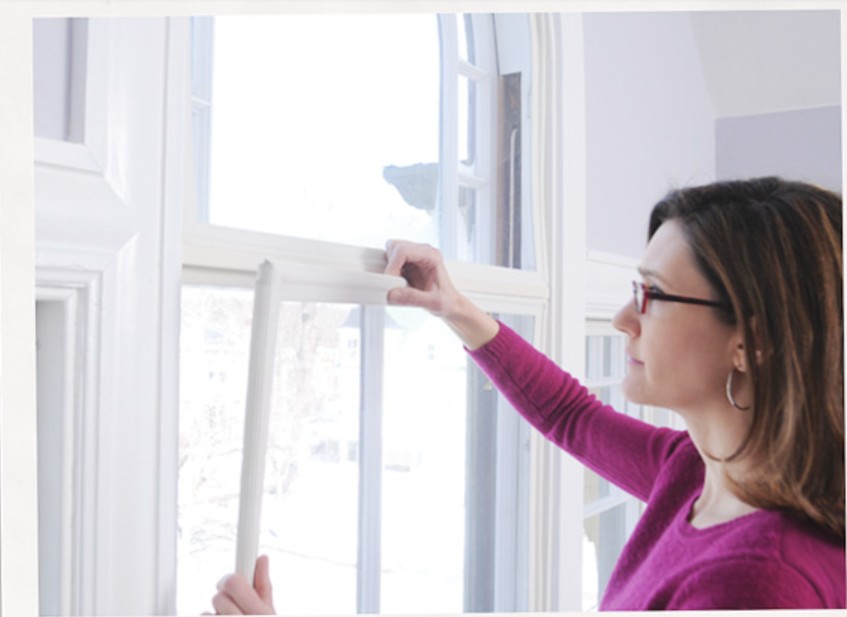
Do you have single-pane windows? If so, consider installing window inserts, similar to storm windows.
Panels are clear acrylic or polycarbonate and single or double-paned. Each insert is custom-fit to the window it covers, sitting snugly inside the frame.
Since the seal is tight and impermeable, it traps air between the two surfaces, creating spatial insulation.
Window inserts cost 50 to 70 percent less than replacement windows. Plus, installation is precise and efficient.
A contractor simply presses the insert into the window frame. Silicone edging or a rubber gasket keeps the panel securely in place.
Thus, there’s no need for hardware or adhesive. Removal is easy, without marring your window casing.
A window insert has six rewards:
– preventing condensation and window rot
– dulling outside noise
– sparing your furnishings of UV damage
– blocking drafts
– a smooth profile with the window frame
– lowering your heating and cooling bills
Indow is one reputable brand of window inserts, detailed here.
Bubble Wrap
Are you thinking, “Seriously, bubble wrap? It seems rather funky, compared with all these other classy options.”
Even so, many people use bubble wrap for window insulation. Its primary appeal comes from being cheap and easily applied.
Since you cut it to size, bubble wrap conforms to odd-shaped windows. Moreover, it’s a great way to recycle plastic, causing no harm to your window glass.
Applying bubble wrap takes only five minutes per window! Using sharp scissors, cut the material to the size of your window glass. After misting the pane with water, press the wrap into place.
Now, the trapped air inside the plastic bubbles will fend off solar heat. The effect mimics a double-glazed window, letting ample light pass through. To remove the material, peel it from one window corner. When applied this way, bubble wrap can last for several years.
Bubble wrap has one drawback – it blurs outdoor objects, pictured here. Hence, it’s best for windows where you won’t miss the views.
Use Low-E Glass Windows
These are fantastic year-round insulators! Low-E glass windows have been in use for the past 40 years. Their invisible metallic coatings regulate heat in every season.
The “E” represents “emissivity,” the ability of a surface to deflect heat. During summer, the window coating repels radiant solar heat, bouncing it back outside. Throughout winter, the ultra-thin metal prevents heat loss through the window.
Since low-E windows are double-paned and tightly sealed, they prevent drafts. Moreover, they minimize condensation and block UV rays. Meanwhile, you’ll enjoy the health benefits of bright natural light.
Generally, low-E windows cost 10 to 15 percent more than regular windows. Still, they can reduce your energy use by 50 percent.
That’s because your home is cooler in summer and warmer during winter. Since your utility bills will be less, it won’t take long to recoup your initial investment.
Blackout Fabric/curtains
Both curtains and drapes come in blackout styles. Their opaque, tightly woven fabrics have insulating properties.
Such textiles ban 90 to 99 percent of sunlight, markedly cutting heat transfer. Meanwhile, they resist heat on warm days, retaining indoor warmth when it’s cold. Blackout fabrics also banish glare and UV exposure.
High-quality products are triple-woven. By this, they lessen outside noise, promoting undisturbed sleep. Plus, you gain total privacy.
Blackout fabrics are polyester, cotton-polyester blends, nylon, or heavy microfiber. Often, they’re coated with a few layers of light-blocking acrylic.
Some have a foam backing. Happily, blackout curtains come in a range of appealing colors, patterns, and prints.
Are you fond of your existing drapes or curtains, not wanting to switch? If so, you can buy blackout liners.
Use a double rod to hang them, placing them behind your current window treatments. Or clip them to the existing rod. Blackout liners complement all curtain weights except for sheers.
The Cheapest Ways to Block Heat from Windows
Window treatments can be expensive, and you might be on a tight budget. If you’re looking to make a cheap investment that will still provide you with the option of blocking heat from your windows, here are two of your best budget options.
Insulated Cellular Shades
Insulated cellular shades have a very nice aesthetic appeal, and they happen to be the one of the most energy efficient window treatment options around.
While they’ll add to the overall efficiency of your home, they also make a room look nice. You can often find them in different colors and styles, so you can customize the look of your home.
Don’t forget, you can install different window treatments in different rooms based on what each room needs for increased efficiency.
Blackout Fabric / Curtains
A lot of people like to install blackout curtains in rooms that get a lot of light. This works out great for bedrooms when you want to be able to sleep in past sunrise, but these curtains can also help block heat from your windows.
They usually look like a traditional curtain from the front, but an extra layer of fabric on the back provides the most protection. These curtains also come in different colors, lengths and styles.
How Much Heat Comes Through Windows?
Did you know that as much as 76 percent of sun heat from outside comes in the house from standard double-pane windows?
These windows are made of glass and even newly installed windows don’t have the ability to completely insulate your home how you would like.
Whether you’re looking to keep heat out in the summer or you want to retain your heated air in the winter, your best option is to invest in window treatments that can increase insulation.
Final Words
Now you have several ways to manage heat transfer. To inform your decisions, consider your budget, decor, and how much effort you want to expend.
Most costly are window inserts and low-E glass windows. Cellular shades, Roller shades, both interior and exterior, are economical and user-friendly. So are blinds and curtains including blackout types.
Do you prefer stylish window treatments? In that case, choose from awnings, curtains, drapes, and Roman shades.
Blackout fabrics boost the insulating power of curtains and drapes. The cheapest options are bubble wrap and window film.
Greater comfort and savings await you!
Related Posts
- How to Stop Sliding Doors from Rattling – Causes and Solutions
- Cheap Ways to Heat a Room – Efficient and Budget-Friendly Solutions
- 11 Ways to Get Rid of Cooking Smells in a Small Apartment or House
- 11 Stores and Sites Like IKEA For Affordable Furniture and Home Products
- All About Polypropylene – Olefin Fabric Sofa Material
- 12 Different Types of Wood for Outdoor Furniture with Pros/Cons
Leave a Reply